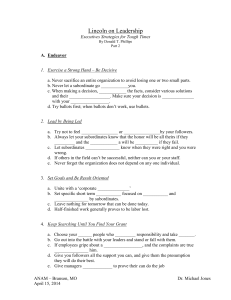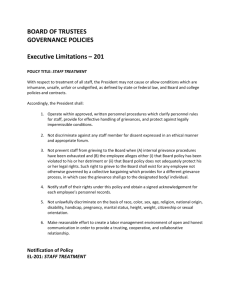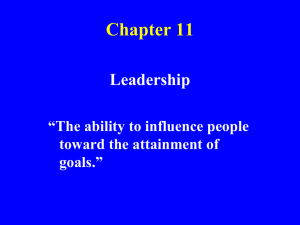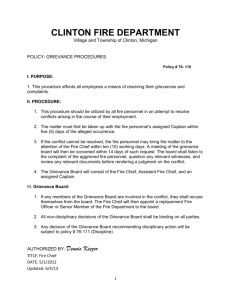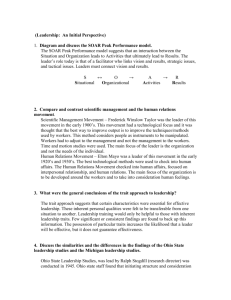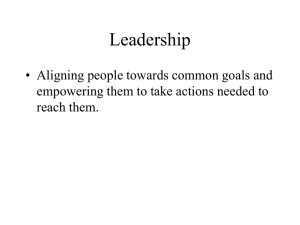Leadership Leadership Approaches to Leadership
advertisement
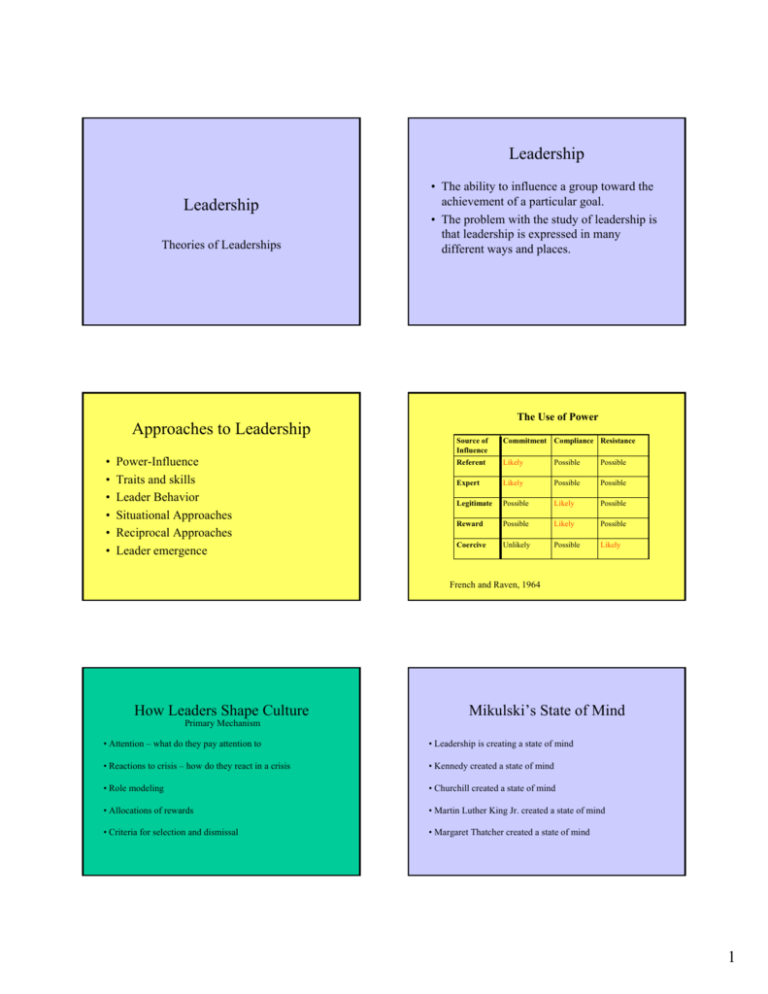
Leadership Leadership Theories of Leaderships Approaches to Leadership • • • • • • Power-Influence Traits and skills Leader Behavior Situational Approaches Reciprocal Approaches Leader emergence • The ability to influence a group toward the achievement of a particular goal. • The problem with the study of leadership is that leadership is expressed in many different ways and places. The Use of Power Source of Influence Commitment Compliance Resistance Referent Likely Possible Possible Expert Likely Possible Possible Legitimate Possible Likely Possible Reward Possible Likely Possible Coercive Unlikely Possible Likely French and Raven, 1964 How Leaders Shape Culture Primary Mechanism Mikulski’s State of Mind • Attention – what do they pay attention to • Leadership is creating a state of mind • Reactions to crisis – how do they react in a crisis • Kennedy created a state of mind • Role modeling • Churchill created a state of mind • Allocations of rewards • Martin Luther King Jr. created a state of mind • Criteria for selection and dismissal • Margaret Thatcher created a state of mind 1 Bennis and Nanus Valclav Havel • The importance of using language truthfully • Common themes of effective leaders: – Develop a vision – Develop commitment and trust- it must be communicated and embodied in the culture – Facilitate organizational learning, at the individual and organizational levels • A democratic state can only be built only if at the same time we build a state that is humane, moral, intellectual, spiritual and cultural Traits of Successful Leaders • Adaptable • Alert to social environment • Achievement oriented • Assertive • Cooperative • Decisive • Dependable • • • • Persistent Self-confident Tolerant of stress Willing to assume responsibility • Modest correlational evidence .20-.30. Skills of Successful Leaders • • • • • • • Intelligent Conceptually skilled Creative Diplomatic Tactful Good speaking ability Knowledgeable of groups • Persuasive • Socially skilled Stogdill, 1974 Derailed Managers • Emotional stability (Not able to handle pressure, moodiness, angry outbursts, etc.) • Defensiveness (tried to cover up mistakes) • Lack of integrity • Weak interpersonal skills (specially problematic at higher levels) • Overconfidence and arrogance especially when it lead to reject sound advice. Commercial Airlines Crews • Foushee and Helmreich (1988)- study the performance of airlines crews, focusing on the captain’s personality. • Captains who were warm, friendly, selfconfident and able to deal with pressure had crews with the best performance. • Captains who were arrogant, hostile, boastful, egotistical, and passive aggressive had the worst performing crews. 2 Weakness of Trait Theory Emerson Electric • Ignores the followers and the situation • Does not differentiate regarding the specific value of each trait • Correlational evidence only (not causal) Behavioral Approaches circa 1950 • Effective leaders behave differently • Ohio State studies– generated 1800 items to create two questionnaires: – LOQ (Leader opinion questionnaire) completed by supervisors – LBDQ(Leader behavior descriptive questionnaire) completed by subordinates – Also two questionnaires of leader effectiveness were used High High Low Intellectual ability Result orientation Interpersonal skills Planning and organizing capabilities Ability to work collaborative with others Maturity Presense (ability to create a positive impression) Major Findings from Ohio State • Consideration– mutual trust, respect, warmth, concern for others, allowing subordinates to participate in decisions. • Initiating Structure– Organizing, planning, defining and monitoring group activities, clarifying and facilitating goals and objectives. Low Production Centered Low performance Low grievance Low turnover Manager’s High performance High grievance High turnover – – – – – – – Leadership Dimensions Manager’s Initiating Structure High performance Low grievance Low turnover • Charles Knight, chairman of Emerson Electric selection criteria for managers: Low performance High grievance High turnover Consideration Univ. of Michigan Employee Centered Task Oriented Blake and Mounton Social Emotional Initiating Structure Consideration Ohio State 3 Turnover and Consideration Grievance and Consideration Grievance and Initiating Structure Hersey and Blanchard’s Situational Theory Turnover and Initiating Structure Low consideration Grievance and Structure Medium High consideration Levels of Maturity (Readiness) One of the most widely practiced leadership model. It has been used as a major training device by many corporations including BankAmerica, Caterpillar, IBM, Mobil Oil, Xerox, and the military. • The theory focuses on followers’ maturity. • Maturity-- the ability and willingness of people to take responsibility for directing their own behavior. Leadership Styles • M1. People are both unable and unwilling to take responsibility to do something. They are neither competent nor confident. • The theory prescribes a different leadership style for different levels of maturity: • M2. People are unable but willing to do the necessary job tasks. They are motivated but currently lack the appropriate skills. • Telling--tells people what, how, when, and where • Selling-- provides both direction and supportive behavior • Participating--the main role of the leader is facilitating and communicating, decision making is shared. • Delegating--the leader provides little direction and support • M3. People are able but unwilling to do what the leader wants. • M4. People are both able and willing to do what is asked of them. 4 Hersey and Blanchard’s Adjusting Leadership style • Low followers Maturity– telling (high task direction and low support) • Moderate followers maturity– selling (task direction and support) • Moderate to high maturity– participating (supportive behavior and a little direction) • High maturity- delegating– (little support and direction) Fiedler Contingency Model • Some situations are easier to manage than others: – Leader member relationships – Task structure – Position structure ( amount of power) Fiedler’s Model • Situational variables are generally accepted but there in not much support for the LPC • Fiedler proposed a cognitive resource theory House’s Path Goal Theory • Leader is responsible for the growth and development of followers. • Different situations call for different blends of leadership styles – – – – Directive Supportive Achievement oriented Participative • Based on Motivation Expectancy Theory (Expectancy, Instrumentality, and valence) Interaction between situation and personality • Task oriented leaders perform best when they have high control or low control • Relationship leaders perform best when control is moderate • LPC– measure whether the leaders is high in task or in relationship. Findings From Fiedler Model (Low) Good Task-oriented Relationship-oriented Poor Favorable I Labor-Member Relations II Moderate III IV Good V Unfavorable VII VIII Poor Good Poor VI Poor High High Low Task Structure High Position Structure Strong Weak Strong Weak Strong Weak Strong Weak High Low Low Low (High) 5 Leader-Member Exchange Theory Leader – Member Exchange Theory Personal Capability And/or Subordinate Competence • Based on Hollander’s Social Exchange Theory (1979) – Situation – Followers – Leader Formal Relationships • He proposed that there is a continuous dynamic exchange between the leader and the followers In-Group – Informal – Autonomy is given to followers – High quality interactions – Participation in important decisions • Out group – Formal – Little autonomy – Low quality interactions – Little participation Vroom & Yetton, and later Vroom & Jago found the following questions helpful in the sequence below: • Quality Requirement (QR): How important is the technical quality of the decision? • Commitment Requirement (CR): How important is subordinate commitment to the decision? • Leader's Information (LI): Do you (the leader) have sufficient information to make a high quality decision on your own? Out-Group Vroom and Yetton Normative Decision Making Model Leader’s Relationships • In group Leader • Recognized the importance of appropriate decisions in leadership • Looked at decisions along two dimensions: – Acceptance – Quality • Suggested a complex procedure for making decisions based on decision tree diagram and a series of questions. • • • • • Problem Structure (ST): Is the problem well structured (e.g., defined, clear, organized, lend itself to solution, time limited, etc.)? Commitment Probability (CP): If you were to make the decision by yourself, is it reasonably certain that your subordinates would be committed to the decision? Goal Congruence (GC): Do subordinates share the organizational goals to be attained in solving the problem? Subordinate conflict (CO): Is conflict among subordinates over preferred solutions likely? Subordinate information (SI): Do subordinates have sufficient information to make a high quality decision? 6 • Autocratic l (Al) • Leader solves the problem along using information that is readily available to him/her • Autocratic ll (All) • Leader obtains additional information from group members, then makes decision alone. Group members may or may not be informed. • Consultative l (Cl) • Leader shares problem with group members individually, and asks for information and evaluation. Group members do not meet collectively, and leader makes decision alone. • Consultative ll (Cll) • Leader shares problem with group members collectively, but makes decision alone • Group ll (Gll) • Leader meets with group to discuss situation. Leader focuses and directs discussion, but does not impose will. Group makes final decision Transformational Leadership Transformational Leadership • Develop a clear and appealing vision • Adapt ideology incrementally to conditions • Develop a strategy for attaining the vision • Identify and eliminate cultural disparities • Articulate and promote the vision • Act confident and optimistic • Articulate the ideology clearly and persistently • Keep actions and decisions consistent with ideology • Express confidence in follower • Use early success in small steps to build confidence Transformational Leadership • Use cultural forms to emphasize ideology • Emphasize continuity in socialization practices General Colin Powell Chairman (Ret),Joint Chiefs of Staff • Manage the politics of subcultures • Develop cultural maintenance leadership at all level A Leadership Primer 7 LESSON 1 LESSON 2 "Being responsible sometimes means pissing people off." "The day soldiers stop bringing you their problems isthe day you have stopped leading them. They have eitherlost confidence that you can help them or concluded that you do not care. Eithercase is a failure ofleadership." Good leadership involves responsibility to the welfare of the group, which means that some people will get angry at your actions and decisions. It's inevitable, if you're honorable. Trying to get everyone to like you is a sign of mediocrity: you'll avoid the tough decisions, you'll avoid confronting the people who need to be confronted, and you'll avoid offering differential rewards based on differential performance because some people might get upset. Ironically, by procrastinating on the difficult choices, by trying not to get anyone mad, and by treating everyone equally "nicely" regardless of their contributions, you'll simply ensure that the only people you'll wind up angering are the most creative and productive people in the organization. LESSON 3 "Don't be buffaloed by experts and elites. Experts often possess more datathan judgment. Elitescan become so inbred thatthey produce hemophiliacs who bleed to death as soon asthey are nicked by the real world." Small companies and start-ups don't have the time for analytically detached experts. They don't have the money to subsidize lofty elites, either. The president answers the phone and drives the truck when necessary; everyone on the payroll visibly produces and contributes to bottom-line results or they're history. But as companies get bigger, they often forget who "brought them to the dance": things like all-hands involvement, egalitarianism, informality, market intimacy, daring, risk, speed, agility. Policies that emanate from ivory towers often have an adverse impact on the people out in the field who are fighting the wars or bringing in the revenues. Real leaders are vigilant, and combative, in the face of these trends. LESSON 5 "Never neglect details. When everyone's mind is dulled or distracted the leader must be doubly vigilant." Strategy equals execution. All the great ideas and visions in the world are worthless if they can't be implemented rapidly and efficiently. Good leaders delegate and empower others liberally, but they pay attention to details, every day. (Think about supreme athletic coaches like Jimmy Johnson, Pat Riley and Tony La Russa). Bad ones, even those who fancy themselves as progressive "visionaries," think they're somehow "above" operational details. Paradoxically, good leaders understand something else: an obsessive routine in carrying out the details begets conformity and complacency, which in turn dulls everyone's mind. That is why even as they pay attention to details, they continually encourage people to challenge the process. They implicitly understand the sentiment of CEO leaders like Quad Graphic's Harry Quadracchi, Oticon's Lars Kolind and the late Bill McGowan of MCI, who all independently asserted that the Job of a leader is not to be the chief organizer, but the chief dis-organizer. If this were a litmus test, the majority of CEOs would fail. One, they build so many barriers to upward communication that the very idea of someone lower in the hierarchy looking up to the leader for help is ludicrous. Two, the corporate culture they foster often defines asking for help as weakness or failure, so people cover up their gaps, and the organization suffers accordingly. Real leaders make themselves accessible and available. They show concern for the efforts and challenges faced by underlings, even as they demand high standards. Accordingly, they are more likely to create an environment where problem analysis replaces blame. LESSON 4 "Don't be afraid to challenge the pros, even in their own backyard." Learn from the pros, observe them, seek them out as mentors and partners. But remember that even the pros may have leveled out in terms of their learning and skills. Sometimes even the pros can become complacent and lazy. Leadership does not emerge from blind obedience to anyone. Xerox's Barry Rand was right on target when he warned his people that if you have a yes-man working for you, one of you is redundant. Good leadership encourages everyone's evolution. LESSON 6 "You don't know what you can get away with until you try." You know the expression, "it's easier to get forgiveness than permission." Well, it's true. Good leaders don't wait for official blessing to try things out. They're prudent, not reckless. But they also realize a fact of life in most organizations: if you ask enough people for permission, you'll inevitably come up against someone who believes his job is to say "no." So the moral is, don't ask. Less effective middle managers endorsed the sentiment, "If I haven't explicitly been told 'yes,' I can't do it," whereas the good ones believed, "If I haven't explicitly been told 'no,' I can." There's a world of difference between these two points of view. 8 LESSON 7 "Keep looking below surface appearances. Don'tshrink from doing so (just) because you might notlike whatyou find." "If it ain't broke, don't fix it" is the slogan of the complacent, the arrogant or the scared. It's an excuse for inaction, a call to non-arms. It's a mind-set that assumes (or hopes) that today's realities will continue tomorrow in a tidy, linear and predictable fashion. Pure fantasy. In this sort of culture, you won't find people who pro-actively take steps to solve problems as they emerge. Here's a little tip: don't invest in these companies. LESSON 9 "Organization charts and fancy titles count for nextto nothing." ." Organization charts are frozen, anachronistic photos in a work place that ought to be as dynamic as the external environment around you. If people really followed organization charts, companies would collapse. In well-run organizations, titles are also pretty meaningless. At best, they advertise some authority, an official status conferring the ability to give orders and induce obedience. But titles mean little in terms of real power, which is the capacity to influence and inspire. Have you ever noticed that people will personally commit to certain individuals who on paper (or on the organization chart) possess little authority, but instead possess pizzazz, drive, expertise, and genuine caring for teammates and products? On the flip side, non-leaders in management may be formally anointed with all the perks and frills associated with high positions, but they have little influence on others, apart from their ability to extract minimal compliance to minimal standards. LESSON 8 "Organization doesn'treally accomplish anything. Plans don't accomplish anything, either. Theories of management don't much matter. Endeavors succeed or fail because of the people involved. Only by attracting the best people will you accomplish great deeds." In a brain-based economy, your best assets are people. We've heard this expression so often that it's become trite. But how many leaders really "walk the talk" with this stuff? Too often, people are assumed to be empty chess pieces to be moved around by grand viziers, which may explain why so many top managers immerse their calendar time in deal making, restructuring and the latest management fad. How many immerse themselves in the goal of creating an environment where the best, the brightest, the most creative are attracted, retained and, most importantly, unleashed? LESSON 10 "Neverlet your ego get so close to your position that when your position goes, your ego goes with it." Too often, change is stifled by people who cling to familiar turfs and job descriptions. One reason that even large organizations wither is that managers won't challenge old, comfortable ways of doing things. But real leaders understand that, nowadays, every one of our jobs is becoming obsolete. The proper response is to obsolete our activities before someone else does. Effective leaders create a climate where people’s worth is determined by their willingness to learn new skills and grab new responsibilities, thus perpetually reinventing their jobs. The most important question in performance evaluation becomes not, "How well did you perform your job since the last time we met?" but, "How much did you change it?" LESSON 11 LESSON 12 "Fit no stereotypes. Don't chase the latest management fads. The situation dictates which approach best accomplishes the team's mission." "Perpetual optimism is aforce multiplier." Flitting from fad to fad creates team confusion, reduces the leader's credibility, and drains organizational coffers. Blindly following a particular fad generates rigidity in thought and action. Sometimes speed to market is more important than total quality. Sometimes an unapologetic directive is more appropriate than participatory discussion. Some situations require the leader to hover closely; others require long, loose leashes. Leaders honor their core values, but they are flexible in how they execute them. They understand that management techniques are not magic mantras but simply tools to be reached for at the right times. The ripple effect of a leader's enthusiasm and optimism is awesome. So is the impact of cynicism and pessimism. Leaders who whine and blame engender those same behaviors among their colleagues. I am not talking about stoically accepting organizational stupidity and performance incompetence with a "what, me worry?" smile. I am talking about a gung-ho attitude that says "we can change things here, we can achieve awesome goals, we can be the best." Spare me the grim litany of the "realist," give me the unrealistic aspirations of the optimist any day. 9 LESSON 13 "Powell's Rules forPicking People:” Look forintelligence and judgment, and most critically, a capacity to anticipate,to see around corners. Also look forloyalty,integrity, a high energy drive, a balanced ego, and the drive to getthings done. How often do our recruitment and hiring processes tap into these attributes? More often than not, we ignore them in favor of length of resume, degrees and prior titles. A string of job descriptions a recruit held yesterday seem to be more important than who one is today, what they can contribute tomorrow, or how well their values mesh with those of the organization. You can train a bright, willing novice in the fundamentals of your business fairly readily, but it's a lot harder to train someone to have integrity, judgment, energy, balance, and the drive to get things done. Good leaders stack the deck in their favor right in the recruitment phase. LESSON 15 PartI:"Use the formula P=40 to 70,in which P stands forthe probability of success and the numbersindicate the percentage ofinformation acquired.” PartII:"Once the information isinthe 40 to 70 range, go with your gut." Don't take action if you have only enough information to give you less than a 40 percent chance of being right, but don't wait until you have enough facts to be 100 percent sure, because by then it is almost always too late. Today, excessive delays in the name of information-gathering breeds "analysis paralysis." Procrastination in the name of reducing risk actually increases risk. LESSON 17 "Have fun in your com mand. Don't always run at a breakneck pace. Take leave when you've earned it: Spend time with yourfamilies. Corollary: surround yourself with people who take their work seriously, butnotthemselves,those who work hard and play hard." Herb Kelleher of Southwest Air and Anita Roddick of The Body Shop would agree: seek people who have some balance in their lives, who are fun to hang out with, who like to laugh (at themselves, too) and who have some non-job priorities which they approach with the same passion that they do their work. Spare me the grim workaholic or the pompous pretentious "professional;” I'll help them find jobs with my competitor. LESSON 14 "Greatleaders are almost always great simplifiers, who can cutthrough argument, debate and doubt, to offer a solution everybody can understand." Effective leaders understand the KISS principle, Keep It Simple, Stupid. They articulate vivid, over-arching goals and values, which they use to drive daily behaviors and choices among competing alternatives. Their visions and priorities are lean and compelling, not cluttered and buzzword-laden. Their decisions are crisp and clear, not tentative and ambiguous. They convey an unwavering firmness and consistency in their actions, aligned with the picture of the future they paint. The result: clarity of purpose, credibility of leadership, and integrity in organization. LESSON 16 "The commander in the field is always right and the rear echelon is wrong, unless proved otherwise." Too often, the reverse defines corporate culture. This is one of the main reasons why leaders like Ken Iverson of Nucor Steel, Percy Barnevik of Asea Brown Boveri, and Richard Branson of Virgin have kept their corporate staffs to a bare-bones minimum - how about fewer than 100 central corporate staffers for global $30 billion-plus ABB? Or around 25 and 3 for multi-billion Nucor and Virgin, respectively? Shift the power and the financial accountability to the folks who are bringing in the beans, not the ones who are counting or analyzing them. LESSON 18 "Command islonely." Harry Truman was right. Whether you're a CEO or the temporary head of a project team, the buck stops here. You can encourage participative management and bottom-up employee involvement, but ultimately the essence of leadership is the willingness to make the tough, unambiguous choices that will have an impact on the fate of the organization. I've seen too many non-leaders flinch from this responsibility. Even as you create an informal, open, collaborative corporate culture, prepare to be lonely. 10 “Leadership isthe art of accomplishing more than the science of management says is possible.” 11
